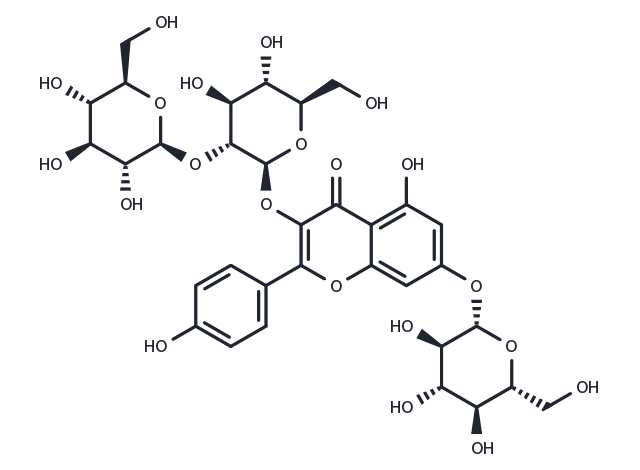store at low temperature,keep away from direct sunlight
Powder: -20°C for 3 years | In solvent: -80°C for 1 year

Kaempferol 3-sophoroside-7-glucoside is a bioactive ingredient in the Lei leaves, belonging to the flavonoid group, which has antioxidant and anti-obesity activities.

| Pack Size | Availability | Price/USD | Quantity |
|---|---|---|---|
| 1 mg | In stock | $ 93.00 | |
| 5 mg | In stock | $ 223.00 | |
| 1 mL * 10 mM (in DMSO) | In stock | $ 589.00 |

| Description | Kaempferol 3-sophoroside-7-glucoside is a bioactive ingredient in the Lei leaves, belonging to the flavonoid group, which has antioxidant and anti-obesity activities. |
| In vitro | The roasting process followed by a 30% EtOH extraction tended to enhance the content of kaempferol-3-sophoroside-7-glucoside. It effectively inhibited pancreatic lipase activity by 62.50 ± 4.81%, which was approximately 1.71 percentage points higher than that of the dried-nonroasted LCL extract (60.79 ± 3.75%). Its bioaccessible fraction obtained from in vitro digestion significantly and dose-dependently reduced intracellular lipid accumulation by adipocyte 3T3-L1 compared with a 30% EtOH extraction. At a concentration of 200 μg/mL, it inhibited lipid accumulation up to 29.55% in 3T3-L1 cells, which indicated that human digestive enzymes converted kaempferol-3-sophoroside-7-glucoside to kaempferol metabolites that have anti-obesity effects.[1] |
| In vivo | Apigenin 7-O-β-D-glucopyranoside and kaempferol-3-sophoroside-7-glucoside, among others, were the main chemical constituents of Pteris wallichiana J. Agardh extract (PEW). In LPS-induced Raw264.7 inflammation and DSS-induced mouse colon UC, PEW pretreatment can significantly reduce the expressions of inflammatory cytokines in vitro and in vivo. In DSS-induced UC mice, PWE can improve the abnormal pathological tissue damage by inhibiting oxidative stress and inflammation-related signaling pathways, and improve the intestinal barrier function.[1] |
| Molecular Weight | 772.66 |
| Formula | C33H40O21 |
| CAS No. | 55136-76-0 |
store at low temperature,keep away from direct sunlight
Powder: -20°C for 3 years | In solvent: -80°C for 1 year
You can also refer to dose conversion for different animals. More
bottom
Please see Inhibitor Handling Instructions for more frequently ask questions. Topics include: how to prepare stock solutions, how to store products, and cautions on cell-based assays & animal experiments, etc.
Kaempferol 3-sophoroside-7-glucoside 55136-76-0 oxidation-reduction Antioxidant Kaempferol 3 sophoroside 7 glucoside Kaempferol 3sophoroside7glucoside inhibitor inhibit
